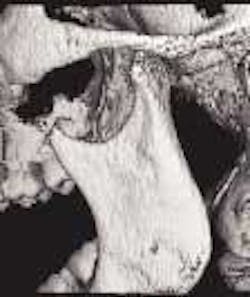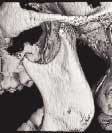Cat scan fever
By Paul Feuerstein, DMD
Imagine a three-dimensional radiograph that shows the precise location of a lower third molar and its proximity to the mandibular canal. Or, perhaps you want to see the real shape and position of the head of the condyle. How about a 3-D look at the sinuses or the exact location of an impacted cuspid?
Of course, you could send your patient elsewhere for a CT scan or MRI at considerable cost and some inconvenience, but the average practitioner is not well versed in reading the slices. Enter the Newtom QR DVT 9000 from Aperio Services, Sarasota, Fla. For a mere $180,000 you can order one of these amazing units. It resembles a mini CT scan unit, but it is actually called a CVBT (Cone Beam Volumetric Tomography scanner), which uses 10 to 30 times less radiation and takes only 70 seconds for a scan. The software used to analyze the scans allows practitioners to effectively peel off layers of tissue down to the skull and teeth and then continue looking inside. It is difficult to explain these revolutionary images, so I encourage you to got to www.aperioser vices.com and download the material or go to the "related links" for more 3-D images and information.
Many of the practices or institutions that have purchased these units will accept referrals into their offices and charge a fee of around $300 for the scan and a report. Because of the way the scan is taken, there is minimal scatter from metal restorations (an all-too-common problem with traditional CAT scans), which means a clearer image. It also is a useful tool for oral surgery diagnosis, TMJ evaluations, implant planning, and 3-D periodontal pocket assessment. The unit has many orthodontic uses, as well as a few other unique applications. For example, some offices accept referrals from pediatricians and ENT specialists because the low radiation and rapid scan makes it less threatening to young children.
Dr. Ivan Dus, assistant professor of orthodontics at Loma Linda University, and Dr. Carl Gugino are principals in the company in conjunction with Quantitative Radio-logy, S.r.l. Dr. Dus was responsible for bringing the first unit into the United States from Italy.
Once we have looked at the TMJ with this amazing unit, the patient may undergo some dental rehabilitation with restorations. It behooves the restorative dentist to achieve an occlusion with no compromises. A new system of transferring the jaw movement to an articulator is on the horizon. KaVo has introduced the ARCUSdigma, which brings the face bow into a new arena. We've all, at some time, come in contact with Gothic arch tracings and other methods of recording mandibular movement and condylar position. There also are devices such as the myomonitor that give information about these relationships. The KaVo unit is a quantitative device that will record jaw movements and allow them to be analyzed and transferred. The "sender" is attached to the lower anteriors and transmits information at an ultrasonic frequency while the patient moves the mandible into different positions. The signal is obtained by the "receiver" (attached to the forehead), which then feeds the information to a little computerized unit. Movements as long as 12 seconds can be recorded and fed to the software. The unit then analyzes the information. At this point, the practitioner can transfer the info to KaVo's Protar7 articulator. The device can also be used to identify functional disturbances directly on the patient. This unit has infinite potential uses for the dental office. More information is available at www.kavo.com, or take a closer look at the next major dental conference you attend.
These new products may seem out of the mainstream now, but they exemplify the exciting future of dental technology.
Dr. Paul Feuerstein installed one of dentistry's first computers when he placed a system in his office in 1978, and he has been fascinated by technology ever since. For more than 20 years, he has taught courses on technology throughout the country. He is a mainstay at technology sessions in New England, including annual appearances at the Yankee.Dental Congress, and has been a part of the ADA's Technology Day since its inception. A general practitioner in North Billerica, Mass., since 1973, Dr. Feuerstein maintains a Web site (www.computersinden tistry.com) and can be reached by email at [email protected].

